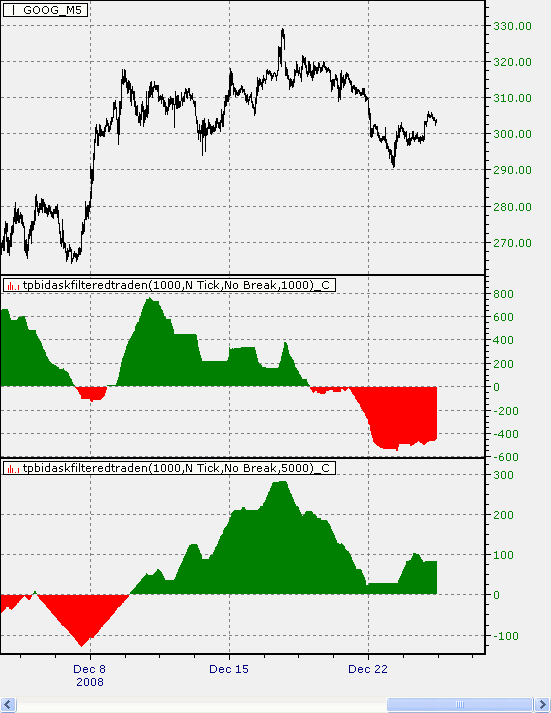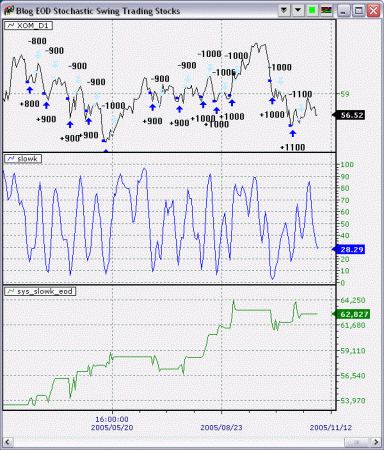Is $17.55 The Bottom For Facebook?
Several days ago while Facebook was selling below $18, I was calling in my real-time chat that $17.50 should be the floor for the stock and that the goal is to print at least $20 and possibly $22 before option expiration. I also mentioned that Mark Zuckerberg will do something quickly right after to secure this low. Next thing we know, after market close that day, he announced that he will not sell his stocks within a year.
Why do I know that it will happen? Because I have seen enough of this happening again and again.
It is a great example on how chart reading, basic reading of option expiration bias, and common sense applied to analyze a stock objectively can give you a low risk entry. No need of voodoo magic like fundamental valuation where everyone can plug in their own preferred parameters, just pure understanding of market dynamics will do.
First, let’s talk about chart formations.
1. The 3 blue up arrows marked a regular 3 pushes down formation. (If you do not know what it is, look up the pattern 3 Pushes in my online eBook Crash Course in Chart Reading.) The pattern points to a retest of the price marked by the red down arrow on the left hand side. And it did it by late June (marked by the 2nd red down arrow to the left).
2. June is the first full month that Facebook traded. It is the reference month as stated in STOPD. The price range of Facebook in June is marked by 2 red horizontal lines. Once Facebook failed to hold the low of June, the 100% range expansion target (right below $18) kicks in. That was tagged several days ago.
3. The break down move started in end of July (marked by the magenta down arrow) formed a pocket zone. Pocket zones are retested almost all the time. The usual time span is within 2 times the original time period spent building the last bottom. In this case, the original time spent is about 2 months, so before year end, Facebook is likely to retest the pocket zone of $23 to $26.
Second, let’s talk about the option expiration factor.
Following is a screenshot of the Facebook put options expiring this and next Friday. I took the screenshot in the middle of the day.
1. Notice the open interest is significantly higher starting from $20 and peaked at $18. None of the higher strike prices, from $21 to $25, has comparable size in their open interest. Since option market makers are likely the writers of these options, do you thing they would just stand there and let these options turning into big fat losses?
Now take a look at the call options.
1. Which strike price stands out with the highest open interest? $22
2. Which strike price has double the open interest comparing to the next line below? $19
3. Again, it is reasonably safe to assume option market makers are the main sellers of these options. Why would they not defending their turf? If Facebook can print a close of at least above $19 and below $22 by option expiration, they stand to collect most of the premium. A job well done.
I have to clarify that the option market makers are not really manipulating the stock price here. Market participants are allowed to buy and sell at the price they want and at the time they want. Someone buying puts from the market makers, the market makers will somehow have to hedge the position or reduce the risk by transferring the position to someone else. In aggregation, as more puts are bought at a specific strike price, a hidden demand is created at the strike price. The dynamics is quite complex and will take several books to explain. So to cut it short, buying would show up in the underlying stock if there are enough put options written within a cluster of strikes.
Third, let’s talk about the often ignored common sense factor.
The Facebook IPO price is $38. Underwriters are still holding onto a huge inventory of the stock. To the retail public, these firms are sitting on a huge loss. But to the underwriters, it is just bad inventory. There is no point to unload the stock now because they will have to take losses and that will impact their quarterly results. So these firms do what they do all the time – trade it out.
Standard engagement for many market making firms would start to load up the stock at about 50% of the IPO price, right below $20. They would also talk to Facebook management raising their concerns about the stock price. The management has to listen and do something because, as a public company, Facebook still need the investment banks to handle their financing and related matters.
So, just like Fed chairman coordinating a rescue plan with European Central Bank, you get this series of planned "good news" to be fed out in sequence. The stock price can then rise steadily to the point where it is acceptable to the major players. Outlooks on the stock will be magically adjusted to the upside so that aggressive traders (they call themselves investors) would be lured to buy the stock from those who bought at the bottom. The cost of the bad inventories are then reduced.
As of today, 2nd good news is already fed out from Facebook. I wonder how many more are in store.
Conclusion
I am going to answer the title question myself here. No, it is not necessarily the absolute bottom. It is just a bottom put in place so that major players can force the hands of the shorts to cover so that a wait and see scenario can happen at $23-$26 area.













Just wanted to note that this ended up being the low, and price shot up to 22/23 just before opex that month.